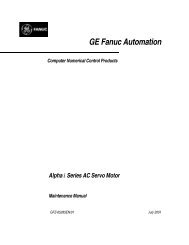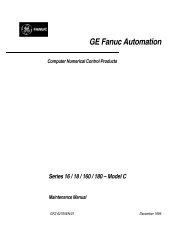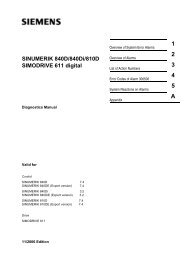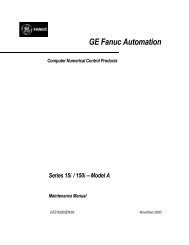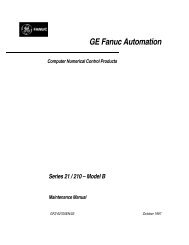15-B Maintenance Mnl, GFZ-62075E/03 - Automation Service Srl
15-B Maintenance Mnl, GFZ-62075E/03 - Automation Service Srl
15-B Maintenance Mnl, GFZ-62075E/03 - Automation Service Srl
Create successful ePaper yourself
Turn your PDF publications into a flip-book with our unique Google optimized e-Paper software.
3. TROUBLESHOOTING AND ACTION TO BE TAKEN<br />
B–<strong>62075E</strong>/<strong>03</strong><br />
(3) The deviation of the return position is very small.<br />
Item<br />
1<br />
2<br />
Possible cause of the<br />
problem<br />
Momentary cable disconnection<br />
Improper connection<br />
of connectors<br />
The Main CPU board, sub<br />
CPU board, or additional<br />
axis board is defective, or<br />
servo amplifier is defective.<br />
How to check the cause<br />
Check that the cable connectors are<br />
clamped and fixed securely.<br />
Check the soldering of each connector<br />
again.<br />
Check the cables are not disconnected,<br />
particularly at the bent portions.<br />
Specify 0 for bit 7 of parameter No. 1800<br />
to suppress drift compensation, and<br />
check the positional deviation using the<br />
diagnosis function (DGN data in parameter<br />
Nos. 3000 and thereafter). The variation<br />
of the offset results in positional<br />
deviation and variation when the machine<br />
stops moving.<br />
Replace the main CPU or sub board, or<br />
the printed circuit board of the servo amplifier.<br />
Action to take<br />
Correct any improper<br />
cable connection.<br />
Replace the axis control<br />
printed circuit board or the<br />
printed circuit board of the<br />
servo amplifier.<br />
How to check the reference position return motion and the position of the deceleration dog<br />
(1) Set each parameter according to the table below.<br />
For parameter No. 1850, set the grid deviation to 0 at the beginning.<br />
Parameter No.<br />
Description<br />
1400 A<br />
Sets whether manual rapid traverse is effective without returning the machine to<br />
the reference position.<br />
1006 A Direction of reference position return<br />
1816 A Sets the capacity of the reference counter for the X and Z axes in that order.<br />
1005 A<br />
Sets whether the reference position return function is effective, and sets how the<br />
machine is returned.<br />
1850 A Sets the grid deviation for the X and Z axes in that order.<br />
1425 A Sets the low feedrate (FL) in the reference position return motion.<br />
1240 A<br />
Sets the coordinates of the reference position in the machine coordinate system.<br />
1024 A Sets the FM feedrate for reference position return with the magnetic switch.<br />
(2) Return the machine to the reference position and check that the motion is normal.<br />
If the reference position needs to be adjusted, follow the procedure below.<br />
(i) For the grid method: The reference position can be adjusted by changing the grid deviation<br />
(parameter No. <strong>15</strong>80). If the reference position needs to be moved by the<br />
distance moved by one rotation of the position detector (pulse coder or<br />
Resolver), also move the deceleration dog.<br />
(ii) For the magnetic switch method: Adjust the position of the proximity switch.<br />
(3) Check the position of the deceleration dog. (Only when the grid method is used)<br />
(i) Return the machine to the reference position.<br />
(ii) Note down the displayed position of the machine when at the reference position.<br />
(iii) While checking the deceleration dog signal (*DECX or *DECZ) using the diagnosis function, move the<br />
machine at low speed from the reference position toward the dog until this signal turns on.<br />
(iv) From the results obtained in (ii) and (iii) above, calculate the distance from the reference position to<br />
the position at which the deceleration dog signal turns on. Adjust the position of the deceleration dog<br />
so that this distance is about half the distance moved by one rotation of the position detector.<br />
– 28 –



